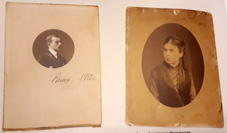
Zakaria Jorjadze - Country of Liquid Sun
Thursday, April 9
A prominent public figure, a successful wine maker occupying a special place in the history of Georgian wine making, a friend and follower of Ilia Chavchavadze and David Sarajishvili – that is how we can refer to Zakaria Jorjadze.
Jorjadze was the first to export Georgian wine and make this product of the Georgian soil well-known. He was awarded a gold medal for exhibiting Kakhetian red wine at the exhibition in Brussels in 1888.
Zakaria Jorjadze obtained special education first in Austria and then in France in one of the important wine making centres, Montpellier. He did his best to introduce the achievement of wine making of that period, European experience and modern technologies to Georgia.
Upon his returning from France in 1887, Jorjadze established a wine cellar in the Kvareli region, on his estate, between the two villages of Eniseli and Sabue. The historical building of the wine cellar, which is equipped with 120 unique kvevris and installations of that time as well as a chateau built in the European style in 1886, has survived to present day. According to the information of his contemporaries, wine was made according to European technology in Jorjadze's wine cellar. The wines made there, based upon the European way of production, as the best export commodity and under the trademark "Prince Z. Jorjadze and Company, were successfully exported to Russia and Europe. The trade house Iv. Mukhran-Batoni and Company and Prince Z. Jorjadze and Company already owned wine storehouses in Moscow, St-Petersburg, Odessa and other cities by that time.
In 1887, Jorjadze, who had just returned to Georgia from France and being familiar with European culture, built a residential house at his family estate which was designed by the first Georgian architect, Simon Kldishvili. The house is located between Sabue and Eniseli, on the territory of the old family building belonging to the Jorjadze family.
Many historical names and events are related to the Jorjadze estate. In 1850s, the French writer, Dumas, visited Zakaria's father, Aleksandre, in Eniseli and mentions the Jorjadze's estate in his book about the Caucasus.
Georgian-Polish relations, which were established as early as the nineteenth century and which have also affected the life of the Jorjadze family, are also worth mentioning. The Tsar's Russia used to exile Polish patriots to Georgia and Georgians to Poland. Obviously, Georgian- Polish families were formed and the family bonds were becoming stronger between them. Zigismund Zlatnicki, who was exiled from Poland, became the Jorjadze's brother-in-law from the side of the Bagrationis. Zakaria's wife was Tamar Bagration-Mukhraneli and Zigismund's son, Elias, was the grandfather of Giorgi Bagrationi who migrated first to Greece and then to Spain where he settled after the Revolution. He established close contacts with the King of Spain, Juan Carlos, and obtained certain dynasty rights in Europe.
They say that Zakaria Jorjadze had brought a can- on devised to hail suppression suppress thunder clouds in the sky mortar to protect his vineyards. The canon Nortira failed to meet his expectations and so he decided to use the mortar for other purposes. When preparations for a feast began at the estate in Enise Jorjadzes' estate within several hours. The Kobulashvilis (descendants of Aleksandre Orbeliani) would come from Kisiskhevi, the Chavchavadzes from Tsinandali and Kvareli and the Jorjadzes, Vachnadzes and Andronikashvilis from adjacent territories. Even Ivane Mukhranbatoni was a frequent guest and close relative of the Jorjadzes. Zakaria Jorjadze had great friendships and business contacts with prominent entrepreneurs of the time including David Sarajishvili, Akaki Khoshtaria and the Zubalashvili brothers. Once, there was a great feast at the Jorjadzes estate which was attended by Ivane Mukhranbatoni. As a joke, Ivane decided to check Zakaria skill as a wine taster and dropped a golden coin into one of the oak barrels full of cognac. Jorjadze walked around the barrels, tasted the cognac and found the barrel with the coin. One more story is connected with Jorjadze cognac.





